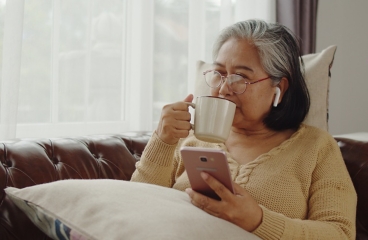
Your Recovery
A needle biopsy of the lung is a procedure to take a sample (biopsy) of lung tissue. The doctor puts a long needle through your chest wall to get the sample. Another doctor will look at the lung tissue with a microscope to check for infection, cancer, or other lung problems.
You may be sore where the doctor made the cut (incision) in your skin and put in the biopsy needle. You may feel some pain in your lung when you take a deep breath. These symptoms usually get better in a few days. If you cough up mucus, there may be streaks of blood in the mucus for the first week after the procedure.
You may need to take it easy at home for a day or two after the procedure. For 1 week, try to avoid heavy lifting and strenuous activities. These activities could cause bleeding from the biopsy site.
It can take several days to get the results of the biopsy. The doctor or nurse will discuss the results with you.
This care sheet gives you a general idea about how long it will take for you to recover. But each person recovers at a different pace. Follow the steps below to feel better as quickly as possible.
How can you care for yourself at home?
 Activity
Activity
- Rest when you feel tired. Getting enough sleep will help you recover.
- Try to walk each day. Start by walking a little more than you did the day before. Bit by bit, increase the amount you walk. Walking boosts blood flow and helps prevent pneumonia and constipation.
- Avoid strenuous activities, such as bicycle riding, jogging, weight lifting, or aerobic exercise, for 1 week or until your doctor says it is okay.
- For 1 week, avoid lifting anything that would make you strain. This may include a child, heavy grocery bags and milk containers, a heavy briefcase or backpack, cat litter or dog food bags, or a vacuum cleaner.
- Ask your doctor when you can drive again.
- You may need to take 1 or 2 days off from work. It depends on the type of work you do and how you feel.
- You may shower 1 or 2 days after the procedure, if your doctor says it is okay. Pat the incision dry. Do not take a bath for the first week, or until your doctor tells you it is okay.
- Do not fly in an airplane or dive deeply (such as in scuba diving) until your doctor tells you it is okay. Avoid any situations where there is increased air pressure.
 Diet
Diet
- You can eat your normal diet. If your stomach is upset, try bland, low-fat foods like plain rice, broiled chicken, toast, and yogurt.
 Medicines
Medicines
- Your doctor will tell you if and when you can restart your medicines. He or she will also give you instructions about taking any new medicines.
- If you stopped taking aspirin or some other blood thinner, your doctor will tell you when to start taking it again.
- Be safe with medicines. Take pain medicines exactly as directed.
- If the doctor gave you a prescription medicine for pain, take it as prescribed.
- If you are not taking a prescription pain medicine, ask your doctor if you can take an over-the-counter medicine.
- If you think your pain medicine is making you sick to your stomach:
- Take your medicine after meals (unless your doctor has told you not to).
- Ask your doctor for a different pain medicine.
- If your doctor prescribed antibiotics, take them as directed. Do not stop taking them just because you feel better. You need to take the full course of antibiotics.
 Incision care
Incision care
- If you have strips of tape on the incision, leave the tape on for a week or until it falls off.
- Wash the area daily with warm, soapy water and pat it dry. Don't use hydrogen peroxide or alcohol, which can slow healing. You may cover the area with a gauze bandage if it weeps or rubs against clothing. Change the bandage every day.
- Keep the area clean and dry.
Follow-up care is a key part of your treatment and safety. Be sure to make and go to all appointments, and call your doctor if you are having problems. It's also a good idea to know your test results and keep a list of the medicines you take.
When should you call for help?
Call 911 anytime you think you may need emergency care. For example, call if:
- You passed out (lost consciousness).
- You have severe trouble breathing.
- You have sudden chest pain and shortness of breath, or you cough up blood.
Call your doctor now or seek immediate medical care if:
- You are sick to your stomach or cannot keep fluids down.
- You have pain that does not get better after you take pain medicine.
- You have a fever.
- You have signs of infection, such as:
- Increased pain, swelling, warmth, or redness.
- Red streaks leading from the incision.
- Pus draining from the incision.
- Swollen lymph nodes in your neck, armpits, or groin.
- A fever.
- Bright red blood has soaked through the bandage over your incision.
- You cough up a lot more mucus than normal, or the mucus changes color.
Watch closely for changes in your health, and be sure to contact your doctor if you have any problems.
Where can you learn more?
Go to http://www.healthwise.net/patientEd
Enter E909 in the search box to learn more about "Percutaneous Lung Biopsy: What to Expect at Home".
Current as of: July 31, 2024
Author: Ignite Healthwise, LLC Staff
Clinical Review Board
All Healthwise education is reviewed by a team that includes physicians, nurses, advanced practitioners, registered dieticians, and other healthcare professionals.

